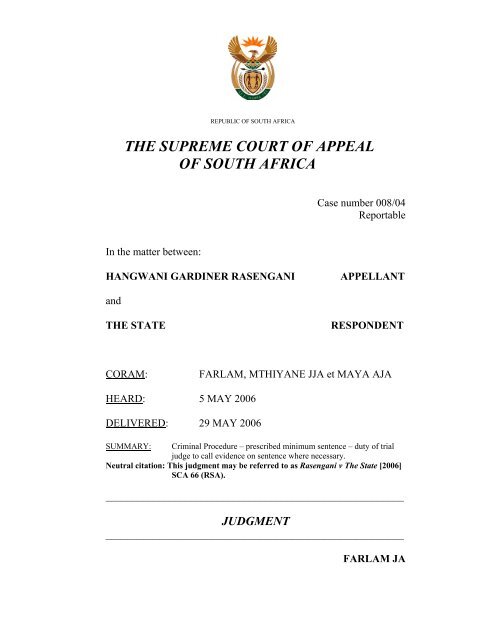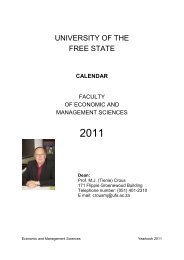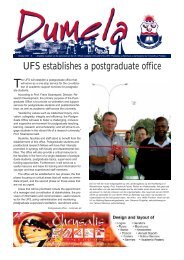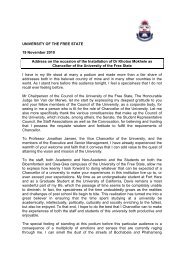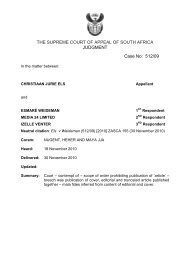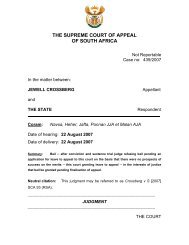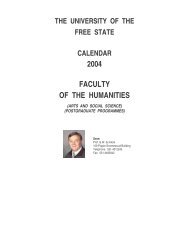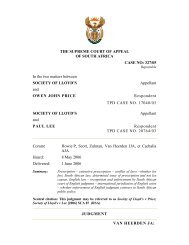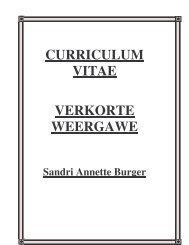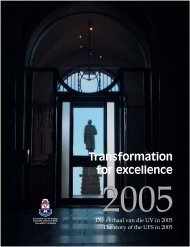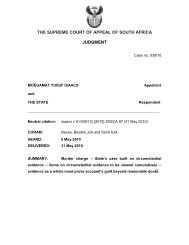THE SUPREME COURT OF APPEAL OF SOUTH AFRICA
THE SUPREME COURT OF APPEAL OF SOUTH AFRICA
THE SUPREME COURT OF APPEAL OF SOUTH AFRICA
- No tags were found...
You also want an ePaper? Increase the reach of your titles
YUMPU automatically turns print PDFs into web optimized ePapers that Google loves.
REPUBLIC <strong>OF</strong> <strong>SOUTH</strong> <strong>AFRICA</strong><strong>THE</strong> <strong>SUPREME</strong> <strong>COURT</strong> <strong>OF</strong> <strong>APPEAL</strong><strong>OF</strong> <strong>SOUTH</strong> <strong>AFRICA</strong>Case number 008/04ReportableIn the matter between:HANGWANI GARDINER RASENGANIAPPELLANTand<strong>THE</strong> STATERESPONDENTCORAM:FARLAM, MTHIYANE JJA et MAYA AJAHEARD: 5 MAY 2006DELIVERED: 29 MAY 2006SUMMARY: Criminal Procedure – prescribed minimum sentence – duty of trialjudge to call evidence on sentence where necessary.Neutral citation: This judgment may be referred to as Rasengani v The State [2006]SCA 66 (RSA).________________________________________________________JUDGMENT________________________________________________________FARLAM JA
2INTRODUCTION[1] The appellant in this case was arraigned before Hetisani J, sitting in theThohoyandou High Court on an indictment containing six counts, namely oneof murder, two of attempted murder, one of pointing a firearm in contraventionof s 39(1)(i) of the Arms and Ammunition Act Act 75 of 1969, one ofpossessing an unlicensed firearm in contravention of s 2, read with s 39(1)(h),of the Act and one of possessing ammunition while not in lawful possession ofa firearm capable of firing that ammunition in contravention of s 36, read withs 39(1)(b), of the Act.[2] He was convicted on all the counts, save that relating to thepossession of ammunition, and was sentenced on 14 December 2000 to lifeimprisonment for the murder, 22 years imprisonment for the first attemptedmurder, 18 years imprisonment for the second, 8 years imprisonment forpointing a firearm and six years imprisonment for possessing an unlicensedfirearm. It was ordered that all the determinate terms of imprisonment were torun concurrently with the life sentence imposed in respect of the murder.[3] The appellant’s application for leave to appeal against the convictionsand sentences was refused by the trial court. On application to this Court theappellant’s application for leave to appeal against the convictions was refusedbut his application for leave to appeal against the sentences imposed uponhim was granted.FACTS[4] It was common cause at the trial that the accused had been involved ina romantic relationship with the complainant on the first attempted murdercharge, Dr Engedzani Paulina Khwanda. (In what follows I shall refer to her as‘the complainant’.) According to the complainant the relationship terminated atthe end of February 1999. The appellant averred, however, that therelationship continued until the date on which the incidents which gave rise tothe various charges occurred, namely 13 July 1999.
3[5] The complainant testified that after her relationship with the appellantterminated she became involved in a relationship with the deceased, whichcommenced in March 1999. According to the complainant the appellant wasnot prepared to accept that their relationship had come to an end. He refusedto move out of the complainant’s house (which she herself appears only tohave stayed in when not on duty at the hospital where she worked). Hethreatened on several occasions to commit suicide unless their relationshipresumed. He was depressed to such an extent that she prescribed Prozac forhim on 21 June 1999 and thereafter Valium on 1 July 1999. (She could notremember doing so but when the prescriptions she wrote out were put to hershe admitted that they were in her handwriting.)[6] The appellant telephoned her on 12 July 1999, and told her that if shecontinued with her relationship with the deceased that his body was not bulletproof and that he, the appellant, would shoot both of them at close range.That evening she went to the deceased’s house, where she was staying forthe week. The next morning, at 5 am she received a telephone call on hermobile telephone from the appellant but did not respond to it.[7] At 6 am the deceased’s domestic worker, Ms Tinyiko Annah Makamu,let the appellant into the deceased’s house, after he had requested entry sothat he could discuss a court case with the deceased, who was an attorney.Once they were in the house the appellant pointed a firearm at Ms Makamu’sforehead and demanded to be shown the room where the deceased wassleeping. (This incident led to the charge of pointing a firearm.) She took himto the room whereupon he opened the door and entered the room.Immediately thereafter he started shooting at the deceased, who was still inbed. The complainant, who was lying on the side of the bed furtherest awayfrom the appellant, went to the appellant and pulled his hand back so that hecould not continue firing at the deceased. The deceased fell down and thengot up and walked outside. The appellant escaped from the grip of thecomplainant and followed the deceased into the passage outside the roomwhere he fired again at the deceased. The complainant then went up to theappellant and said to him, ‘now that you have killed Khathu [the deceased],
4why can you not kill me too?’ The appellant replied that before he could killher he wanted first to aim at her stomach, because she might be carrying thedeceased’s baby and he wanted to destroy the foetus before he killed her. Hethen loaded bullets into the firearm and shot her at close range in herstomach. She fell down. The appellant then went over to where the deceasedwas lying and shot him again. She got up and walked to the gate where shefell down again. The appellant came to her, took some bullets out of hisjacket, put them next to her head and said that he wanted to shoot her headso that her parents would not be able to recognise her. He knelt down,produced a knife and screwdriver and stabbed her in her back. He then stoodup and kicked her all over her body. He told her that he was going back to thehouse in order to cut off the deceased’s genitals to teach him a lesson andthat he would then come back to her again. When he entered the house shemanaged to stand up and run away. She collapsed at the nearby house of thewitness, Mr Musia.[8] Musia came out and covered her with a blanket and then, because hecould not get through to the police on his house telephone, he decided to goto the police base in his motor vehicle so as to call them to the scene. As hewas walking towards his vehicle the appellant arrived, with a firearm in hishand, and said that he was looking, as he put it, for his naked wife. Musia toldhim that his wife had gone out of his yard through the gate, whereupon theappellant left. Musia drove to the police base, told them briefly what hadhappened and then drove back to his house followed by the police. When hegot back to his house and had parked his vehicle he saw the appellantwalking in front of his house. Musia told the policeman in the police vehiclewhich had followed his car that the man walking in front of his house was theman who had been looking for the complainant.[9] The policeman, who was Inspector Mabasa, asked Musia to follow himin the police vehicle. Mabasa went after the appellant. Musia did not see whathappened but heard a shot and when he arrived at the spot where Mabasaand the appellant were he found the appellant lying on the ground. He helpedMabasa to carry the appellant to the police vehicle and Mabasa then drove
5away taking the appellant with him. After this Musia took the complainant tothe deceased’s house, from where she was taken to hospital.[10] According to Mabasa, the complainant on the second attemptedmurder charge, he accompanied Musia from the police base to his house.When they arrived there he saw the appellant passing by in the street with afirearm in his hand. On being told that the appellant was the person who hadbeen involved in the earlier shooting incident, he told him to stop. Theappellant turned towards him and pointed his firearm at him. Mabasa hidbehind a rock in the vicinity. The appellant fired a shot towards him, whichmissed. The appellant then said that he could not surrender himself to apolice officer and that he would rather shoot himself. He then pointed hisfirearm towards his armpit and shot himself. He fell to the ground. Mabasasaw blood oozing from his armpit. He took possession of the firearm and onsearching the appellant found a screwdriver and a knife. The appellant wasthen taken to hospital. In addition to the screwdriver which Inspector Mabasafound on the appellant another screwdriver was found in the passage of thedeceased’s house near the deceased’s body.[11] It appears from the report of the post-mortem examination performedon the body of the deceased that in addition to a gunshot wound through hisleft eye into the left hemicranium which caused his death there were alsosuperficial lacerations (puncture marks) on the deceased’s right neck and leftshoulder and on both buttocks as well as in the left pubic area. Dr Tshivhase,who performed the post-mortem examination said that these marks couldhave been caused by either the screwdriver found near the deceased’s bodyor the one found on the appellant by Inspector Mabasa.[12] Dr Tshivhase also testified regarding the injuries received by thecomplainant. According to her the complainant had a gunshot wound in theabdomen which caused, amongst other things, extensive damage to thebowel, liver and spleen. The spleen was ruptured and had to be removed.There was also a laceration, caused by some sharp object, on the right side ofher neck. There was also what the witness described as minor tissue injury on
6the left side of the complainant’s face and some superficial puncture marks onher back.[13] After the appellant was convicted the complainant testified as to theeffect the attack on her had had on her life. She said that before the incidentshe had wanted to specialise in paediatrics but that this field of specialisationwas no longer open to her because as a result of the removal of her spleenher chances of getting infections of various kinds have been substantiallyincreased. She said further that because of this she was restricted fromseeing most patients. She also described how, when she sees patients in outpatients’department with injuries similar to hers, she has flashbacks to herown experiences which prevent her from functioning as swiftly and efficientlyas she should in the circumstances. She also stated that because of thetraumatic experiences she underwent she had been seeing a psychiatrist.JUDGMENT <strong>OF</strong> <strong>THE</strong> <strong>COURT</strong> A QUO[14] In his judgment on sentence the learned trial judge referred to s 51 ofthe Criminal Law Amendment Act 105 of 1997 which provides in subsections(1) and (3), read with Part I of Schedule 2, that a person convicted of amurder which was planned or premeditated must be sentenced to lifeimprisonment unless the court is satisfied that substantial and compellingcircumstances exist which justify the imposition of a lesser sentence. Hefound that the murder of the deceased was premeditated and stated that thiswas the reason that he was obliged to impose a sentence of life imprisonmenton the appellant in respect of count 1, the count of murder. He had earlierstated that the appellant had committed the offences in respect of which hehad been convicted ‘seemingly under very emotional provocation’. He said,however, that ‘this vital point was not fully canvassed by the defence’ nor wasit contradicted by the State. Later the judge mentioned that he had alreadyalluded to the fact that the appellant had ‘perhaps [been] under extremeemotional provocation’ at the time of the commission of these crimes and saidthat ‘this factor would count very strongly in his favour but there is noevidence before the court to support it.’ In this regard reference was made tothe fact that the appellant had been seen by four psychiatrists.
7[15] The learned judge also said that if the case had come before himbefore 1997, by which he clearly meant prior to the coming into operation ofAct 105 of 1997, ‘the sentence to be imposed here today would be fardifferent from what it is’.SUBMISSIONS BY COUNSEL[16] Counsel for the appellant submitted that the trial judge court hadmisdirected himself in imposing the sentence he did on count 1 because,having found that the murder was premeditated, he failed to consider whetherthere were substantial and compelling circumstances present. It wasaccordingly necessary, so counsel submitted, for this court on appeal toaddress itself to the question which the trial judge had failed to consider.[17] Mr Ntlakaza, for the State did not dispute this contention: he concededthe misdirection contended for but submitted that this court should concludethat no substantial and compelling circumstances were present. He alsoconceded that the sentences on the two counts of attempted murder (counts 2and 3) and the count of pointing a firearm in contravention of section 39(1)(i)of Act 75 of 1969 (count 4) were excessive and should be replaced bysentences which this court considered appropriate. As regards the sentenceimposed on count 4, namely eight years imprisonment, he pointed out that themaximum sentence provided for by s 39(1)(i) is only six months imprisonmentso that the sentence imposed by the trial court was 16 times more severethan the maximum provided by the statute.DISCUSSION[18] The difficulty I have in regard to the question as to whether substantialand compelling circumstances were present is created by the fact that,although it appears that the appellant may well have behaved as he didbecause of severe emotional stress (I do not agree that it is appropriate to callit emotional provocation) this matter was not fully canvassed in evidence. Weknow from the evidence that the appellant was unable to accept that hisrelationship with the complainant had come to an end, that he was beingtreated for ‘depression and stress’, that he had threatened to commit suicide
8and indeed tried to do so on the day the crimes were committed and that thecomplainant had prescribed anti-depressants for him, one of which he wastaking at the time when the crimes were committed. Although three of the fourpsychiatrists who saw him did so pursuant to the provisions of s 79 of theCriminal Procedure Act 51 of 1977 in order to ascertain whether he was fit tostand trial and had criminal capacity when the alleged offences werecommitted, it is likely in my view that as a result of their interviews with himthey would be able to express opinions as to the emotional stress to which theappellant was subject when the crimes were committed, how serious hisdepression was and whether, and, if so, to what extent it provided, at least inpart, an explanation for his behaviour, which, as appears from the summarygiven above was in some respects what I think may appropriately bedescribed as bizarre.[19] In my view the judge should, in order to see to it that justice was donein this case, have called one or more of the psychiatrists who interviewed theappellant so as to obtain information on the matters I have set out above.That he had the power to do so appears clearly from s 274(1) of Act 51 of1977 which provides as follows:‘(1) A court may, before passing sentence, receive such evidence as it thinks fit in orderto inform itself as to the proper sentence to be passed.’[20] In this regard it is also helpful to call to mind what Curlewis JA said in Rv Hepworth 1928 AD 265 at 277, viz:‘A criminal trial is not a game where one side is entitled to claim the benefit of any omission ormistake made by the other side, and a judge’s position in a criminal trial is not merely that ofan umpire to see that the rules of the game are observed by both sides. A judge is anadministrator of justice, he is not merely a figure head, he has not only to direct and controlthe proceedings according to recognised rules of procedure but to see that justice is done.’[21] In the present case to close one’s eyes to the fact that evidence onthese matters was not led might well lead to the imposition of a sentencewhich is not in accordance with justice. I say that because the factors I havelisted in para 18 above indicate, as the trial judge himself was aware, thatemotional factors may have been present, which combined with the
9appellant’s state of mental health at the time, may have caused him to behavein the way he did.Even if such factors were present, the crimes which he committed were veryserious and called for severe sentences but this does not mean that thesentence prescribed for premeditated murder should have been imposed ifsubstantial and compelling circumstances were present. Whether they wereor not can only be decided once the further evidence to which I have referredhas been led. Similar considerations apply as regards the other crimes inrespect of which the appellant was convicted.[22] In the circumstances I think that in order for justice to be done in thismatter it is necessary for this court to set aside the sentence imposed by thetrial court, to send the matter back for one or more of the psychiatrists whoexamined the appellant to testify on the matters mentioned above, for thecourt in addition to hear such evidence on these matters as the State and thedefence may wish to lead and for sentence to be passed afresh on all thecounts on which the appellant was convicted.ORDER[23] The following order is made:The sentences imposed on the appellant are set aside and the matter isremitted to the trial court to deal with the matter as set out in para 22 of thejudgment of this Court.……………..IG FARLAMJUDGE <strong>OF</strong> <strong>APPEAL</strong>CONCURRINGMTHIYANE JAMAYA AJA


